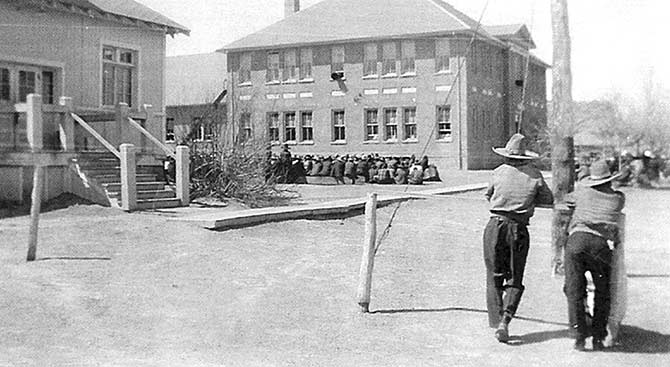Crownpoint to celebrate 100 years

(Courtesy photo - Crownpoint Historical and Cultural Heritage Council)
A meeting is held in the 1920s at the Pueblo Bonito Agency Boarding School in Crownpoint. The kindergarten building (later town hall) is on the left.
By Leonard Perry
Crownpoint Historical and Cultural Heritage Council
CROWNPOINT, July 23, 2010
Crownpoint has a rich historical background that needs to be shared and celebrated. The Crownpoint Historical and Cultural Heritage Council endeavors to accomplish this. The council began in the spring of 2008 as a project I started while investigating the history of the Crownpoint Eastern Navajo Agency.
On Sept. 30, 2008, it became a non-profit corporation and is certified with the Navajo Nation. We are working to obtain incorporation from the state of New Mexico.
The articles of incorporation states, "The purpose of the corporation is to advocate an appreciation for the history of Crownpoint and its surrounding communities, to educate the public on this history and the culture..."
The council's board of directors includes Leonard Perry, president; Bess Seschille, vice president; Alice Benally, member; and Bonnie Yazzie, member.
The council works with the Crownpoint Chapter House, the chapter's land-use planning committee, Navajo Nation Parks and Recreation, Navajo Nation tourism department, Navajo Nation Division of Economic Development, Eastern Regional Business Development Office and the Bureau of Indian Affairs.
The council's goals include a Crownpoint Boarding School reunion, identifying, protecting and restoring historical buildings and landmarks, compiling biographies of past and present influential people and hosting a symposium on the history of the past 100 years and the centennial celebration.
Long-term goals include the establishment of a museum and cultural center and community activities and development.
The region surrounding Crownpoint has been occupied by a number of cultures for thousands of years.The Anaasází lived in the region over 1,000 years ago. Kin Ya'á, or the Towering House site, east of Crownpoint is a remnant of this culture.
This site is considered the origin of the Kiiya'ánii clan, one of the four original clans of the Diné. This site is also considered the home of Rainboy's parents in the legend of the Hail Way origin.
The Eastern Agency is depicted as the doorway to the east of the Navajo Nation.
Later, the Diné began to call the Crownpoint area, T'iists'oozi Ndeeshgizh, "the gap where thin trees grew." The story among the local elders is that sometime in the early 1900s, a wagon traveling up the canyon near the site southeast of Crownpoint dropped a willow seed and from the seed trees began to grow in the gap near T'iists'oozi Ndeeshgizh.
Samuel F. Stacher set the stage for modern development of the area. Stacher was born in Ohio in September of 1875.
On April 1, 1909, Stacher became an agent for the Eastern Navajo jurisdiction. Stacher, on horseback and wagon, along with several hired Navajo policemen, traveled to various locations to get acquainted with the Diné and to see the land under his jurisdiction.
Stacher had three crews of surveyors working in the fields making allotments of 160 acres to each Navajo family in the Eastern Navajo jurisdiction. Stacher decided to locate the agency headquarters in an area with a gentle slope to the north and surrounded by mesas. He named this site, "Crownpoint" because of the rock points that looked like crowns.
Agency workers and volunteers worked to improve the new Pueblo Bonito Boarding School.
The area was known as a meeting place among Diné clan groups where ceremonials were held.
The Diné heard of this new person who was working for "Wááshindoon" and now in charge of their homeland. Because of his height, 5'6", the Diné called him "Naat'áanii yázhi."
In March 1910, the Stacher's moved from the Chaco Canyon site to the Duncan McGillivary sheep ranch located five miles north of the site of the new agency he had chosen. The following April, the Stachers moved to Crownpoint where they lived in tents.
Lumber was brought in from the McGaffey Lumber Company. A "box-car type" building was erected along with other buildings. A man from Aztec, N.M., was awarded a contract to make bricks.
A three-room stone house was built for the Stacher family and construction started for a dormitory building on the west side of the "campus." The construction of the Pueblo Bonito Boarding School was on the south end of the campus.
Eventually, three dorms were built for boys on the west side and three dorms for the girls on the east side of the campus. A number of Navajo men were hired to cut and shape stones to build the blacksmith shop, the laundry and carpentry buildings.
By 1920, Stacher with local Navajo leaders and other agency leaders organized the first Inter-Tribal Indian Ceremonial in Crownpoint, the forerunner of the present Inter-Tribal Indian Ceremonial held in Gallup.
The first ceremonial included horse races, foot races, rodeo events, a parade, arts and craft exhibits, and traditional tribal dances with large fires at night. Families came in wagons and horses. By 1922, the ceremonial was transferred to Gallup.
From its small beginnings to the present day community, Crownpoint has emerged as the hub of activity with various tribal, state and government offices, schools and small businesses. This year in 2010, Crownpoint celebrates its 100 years of existence with events tied in with the annual Eastern Agency Fair.
Crownpoint is deeply rooted in historical times with families that resided in this area for generations.
In future editions of our newsletter, the Crownpoint Baahane', more details will emerge regarding the early development of Crownpoint.

